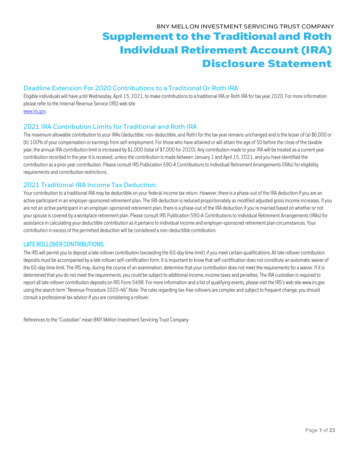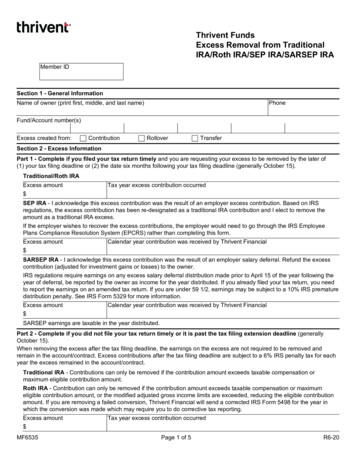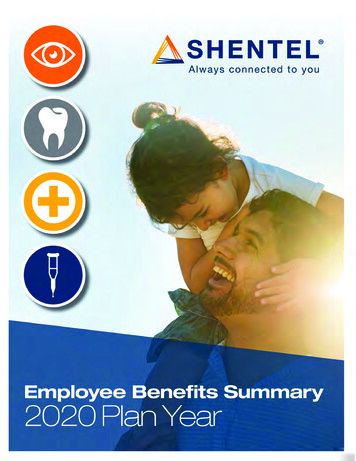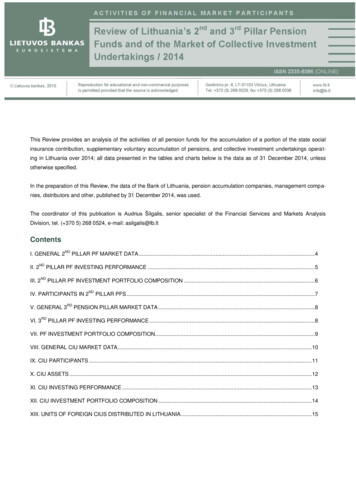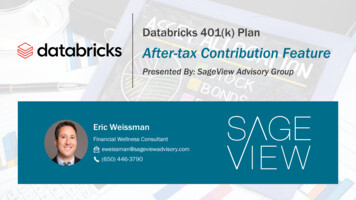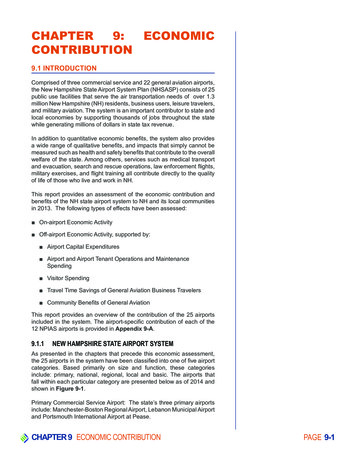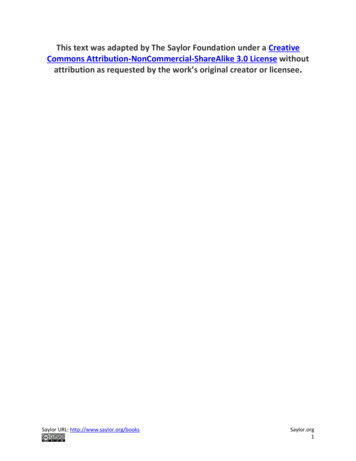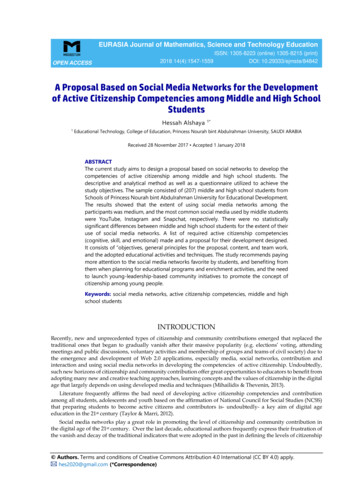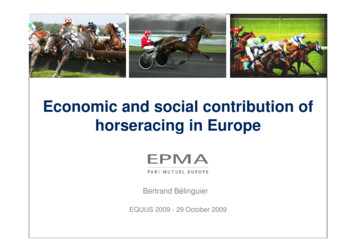
Transcription
Economic and social contribution ofhorseracing in EuropeBertrand BélinguierEQUUS 2009 - 29 October 2009
The Association Non for profit association based in Brussels Created in June 2007 Membership: European Pari Mutuel Operators directly contributingto Racing10 countries represented : Austria, Finland, France, Germany,Ireland, Italy, Norway, Sweden, Switzerland, UK 14 billion of bets collected by EPMA Members in 2008 1,5 billion went back to racing and horse industry 1
MissionPromote Pari Mutuel betting on horseracing and its business model Lobbying in Brussels and in various European jurisdictions EPMA White Paper 2008 – How the Pari Mutuel works, its benefits and theimpact of funding for Racing EPMA study on the economic and social contribution of horseracing inEurope 2009Our position: Right for Member States to define a national betting legal framework Recognising the right of horseracing sport event organisers to get a fairreturn Promoting the horseracing sport by preserving integrity Implementing obligatory responsible gaming rules Coordination of Member States to fight illegal betting activities 2
Objectives of EPMA studyThe document builds on a joint research investment byMcKinsey and EPMA members on the horse racing sector inEurope, to describe the economic flows in the industry andcompare the funding of horse racing across countries.Building a comprehensive and rigorous fact base on the horseracing sector at the European level is a progressive and longterm effort that will be repeated by EPMA on a yearly basis inorder to support their ongoing dialogue with policy decisionmakers in Europe. 3
European horse betting and horse racing industry – a largeand vivid sectorThe European horse racing industryThe European horsebetting industryPeople 40 000 breeders Over 300 000 jobs1of which 155 000 people directly employedLand 500 racecourses throughout Europe 4% of European agricultural land used toproduce horse feed2 20 million punters EUR 35 bn of bets EUR 1.6 bn of taxespaid to governments3Events 80 000 horse races per year On average 18 horse races/hour(considering the period 12am to 12pm)Horses 170 000 race horses EUR 390m of race horses public sales41 Estimates based on horse betting turnover when no direct information is available2 Estimates based on 22 European countries3 Calculated on 12 European countries (including all EPMA members except Austria)4 Based on sales of 9 main European agencies/auction housesSOURCE: EPMA; IFHA; UET; Ecus; PMU; 2009 updated information from Equus 2001; ATG 4
The horse racing footprint on the European economyis significant, with EUR 6 bn of economic impactApproach to estimate horseracing impact/other equine contributionHorseracing impact on the economy includes: Betting operators' contribution: betting revenuesexcluding returns to punters and governments Race goers' contribution: expenses incurred byrace goers during race days (admission fees hospitality when data are available) Owners' contribution: net expenses to train horsesand take part in races1 Other contributions: e.g., revenues injected forsponsoring (other players than betting operators),State subsidiesOther equine impact includes: revenues generatedby sport/leisure activity and other activitiesPerimeter: Estimates on 6 countries (France, Finland, Ireland,Norway, Sweden, and UK) Extrapolation on Europe:– Horse acing impact: rationale based on horsebetting market share of these 6 countries versusEurope– Other equine contribution: rationale based onthe average ratio equine contribution/horseracing contribution calculated for countrieshaving disclosed these dataKey figures – Estimates in EuropeHorse racing impactEUR millionsOther equine impact11,8205,6303,950Extrapolated otherequine contribution1,880Taxes paid by bettingoperators (EUR 004402203305303302002,4101,520890TotalUK250France Ireland2 Sweden Finland Norway1,120013010Other151 No reliable data to include capital investment to buy horses2 Excluding contribution from stallion/broodmare breedingSOURCE: McKinsey analysis; EPMA data; public data 5
The horse racing sector is closely linked with the equinesector and beyond, flows through the overall economyTotal equine sectorEnd usersSpecific stakeholderProfessionals at the intersectionhorse racing/other equineImpacted sectorsNot exhaustiveHorse racingracingHorseHorse racing bodies – racingassociations, racecourses,horse racing schools, Horse racing professionals –trainers, jockeys, drivers, oncourse workforce, employeesof training centersOther equine Horse betting bodies2 – PariMutuel betting operators,bookmakers, PuntersOwnersBreedersStable echnicians Race goersEquestrian Sport– ridingschools, federations Leisure/other – farmsdedicated to horse tourism,organizers of riding tours, horsetherapy centers, RidersIndirect impacted employees/sectors1 – insurance agents, caterers,broadcasters, carriers, contractors, journalists/photographers, auctionhouses, brokers, farmers providing fodder, State1 Assuming 100% of their activity is not dedicated to horses/horse racing2 Partially active outside the horse racing sector (in particular, bookmakers who generally offer bets on a wide range of sports) 6
Horse racing employs directly and indirectlymore than 300,000 people throughout EuropeKey A wide range of different jobs are related to horseracing – selected examples of direct employeesBreedersEquineveterinariansStable addlersDriversEmployees ofthe horse bettingsectorOverall horse racing employment represents 310 000 direct and indirect jobs1 155 000 direct jobs1 2.4% of jobs in the agricultural sector2 1.8 direct and indirect employees/race horse31 Estimates based on horse betting turnover when no direct information is available2 Ratio on direct employment3 Ratio on total employment (direct and indirect)SOURCE: EPMA; Global Insight; IFHA; UET 7
In addition, horse racing contributes to the preservationand care of a vivid countrysideHorses contribute to countryside preservation as well as to land settlement. Some European regionsbenefit tremendously from horse-related activitiesArea needed to producehorse feedMillion hectares – Europe2Basse Normandie (France)% of nationalagricultural negroTurkeySardiniaGreat Britain0,95AlbaniaMaltaGreeceCyprusRegion profile 1.5m inhabitants 17 589 km 1st French region for horse breedingKey facts on horse industry: 93 000 horses1 ( 10% of French horse population) 44 different breeds1 EUR 620m of revenues generated by the equine sector1 9 200 employees in the horse sector (including 933employees in horse racing associations)1 26% of the worth agricultural land dedicated to horses(area for farms, grazing, hay production)1 Well-known racecourses in Deauville and Cabourg Sizeable yearling sales in Deauville (EUR 26m) World equestrian games to be hosted in Caen in 2014County Kildare 00,30,10,10,13,85614Region profile 186 100 inhabitants 1 693 km2Key facts on horse industry: 15% of Irish horse meetings 11% of Irish breeders and 23% of Irish trainers EUR 43m of impact on local economy and 2000 part-timejobs generated by Punchestown festival EUR 28m of fees paid for in-training horses1 2006 data2 Calculated on 22 European countriesSOURCE: Conseil des Chevaux de Basse Normandie; 2009 updated information from Equus 2001; Tote Ireland; Internet 8
Horse racing also fosters social cohesion, Some races are events of national importanceHorse betting attracts numerous and various puntersExample – Elitloppet races in SwedenExample – Profile of French puntersOne of the world’s largest trotting race Horses and drivers from 10 countries participated in 2009 race 53 500 visitors EUR 28 m of revenues EUR 9 m1 of economic outcome for Stockholm EUR 1672 of average expenses for visitorsIn France, horse betting attracts numerous people 6.5 million of punters 600 000 punters/day with a diversified profile Breakdown by age attracting diversified spectatorsBreakdown by ageOther16%18-34Breakdown by origin 4925-34Stockholminhabitants21%38%55-64 17%23%23%35-44Breakdown by genderVisitors 62%Tourists45-54Women25%40%42%Men60%33%35-49 who are keen on betting in group 67% of punters began to bet through their relatives or friends whoalready bet 50% of punters bet in group1 2007 figure2 Expenses for tickets, hotel, food, and shopping (excluding betting)SOURCE: Elitloppet website; ATG; PMU report 9
as well as social insertion, and embodies a truly European activityHorse racing is a vector of social insertion Dedicated championships are organized for disabled people and a truly European activitySeveral racing circuits are organized across different European countriesCircuitRace category Localization of the circuit races“European GrandCircuit”13 racesCreated in 1956Key facts on European Para Equestrian Championship Organized by FEI (Fédération Equestre Internationale), the international bodygoverning equestrian sport Held every 4 years Next edition hosted by the Norwegian Equestrian Federation in August 2009(partners include the betting operator Norsk Rikstoto) Dedicated to equestrians from around the world, with a wide rangeof disabilities (athletes are classified according to their level ofdisability/impairment) 2 disciplines: dressage and drivingPara equestrian sport is based on the principlethat a disability should not impede one fromcompeting and achieving personal bests (FEI)“Gallop Challenges1”15 racesLaunched in uropean Circuit ofTrottingFrench Trotting”23 racesCreated in 2007“Mediterranean FlatFlatJockey Championship”6 racesParticipation of more than 7nations (only few are listed)Launched in 2005BelgiumSpainSwitzerland“Challenge EuropeanAll Weather”5 racesCreated in eceItalyMoroccoSpain1 "Les Défis du Galop"2 "Tour Européen du Trotteur Français"SOURCE: FEI; PMU; Internet 10
Betting is key to horseracing fundingHorseracing has a specificfinancing mode, relying essentially on betting andowners investmentBetting operators have a key role in organizingbets and funneling economic flows to the industryRevenue sourcesRevenue breakdown forglobal sports market andselected sports(2008 estimates1)OwnersBettingCommercialBroadcastHorse racing professionals Trainers Owners Jockeys Breeders OthersPayment of prizemoney/bonusesMatchdayRaceday/broadcast/other commercialRace courses41%22%30%45%20%36%Redistribution of a share of bettingturnover through: Net profit Levy Non mandatory returns to racingassociations (e.g., ng operators41%25%Big Horse(American racingFootball)WinningsBetsPunters1 2006/2007 data for Big 5 European football leagues; 2006 data for British Rugby Union and HorseracingSOURCE: McKinsey analysis; Deloitte data; PricewaterhouseCoopers data 11
The betting activity encompasses different betting typesBetting typePari MutuelbettingDescription Bets are placed together in a pool Final payout is not determined until Fixed oddsbettingExamples of Europeanoperators offering these bets 74%the pool is closed and the race is runPay-off odds are calculated by sharingthe pool among winning punters afteran automatic take-out (for State, returnto the horse racing sector, the operator'sexpenses)Betting operators' profit is not linked tothe outcome of the race and the numberof winning tickets Each bet is negotiated individually Share ofhorse bettingstakes(worldwide1)26%between the betting operator andthe punterPayout is agreed at the time the betis soldBetting operator profit is directlydependent on the outcome of the race1 2007 IFHA estimates. Fixed odds are calculated by taking into account bookmakers' margins/profitsSOURCE: EPMA; IFHA 12
Horse racing employment is closely correlatedwith horse betting turnoverESTIMATESCorrelation – Horse betting turnover vs. horse racing direct employmentCorrelationcoefficient: 0.9Direct e higher the horsebetting turnover thehigher theemployment in thehorse racing sector30,00025,000 010,00012,00014,00016,000Horse betting turnoverEUR mSOURCE: McKinsey analysis; EPMA data; IFHA data 13
Horse breeding dynamism is driven by prize money financedby bettingESTIMATESThe higher the total prize money, the higher number of breeders (flat, jump, trotting)Betting operators contributeto the funding of prize moneyCorrelationcoefficient: 0.82Breeders2Number14,000France12,000Prize money: Total prize money: amount of moneydistributed by racecourses to rewardwinning horses Average prize money/race: indicatorthat illustrates attractiveness of horseraces for ownersRecipients of prize money: Owners, trainers, jockeys are theusual players receiving prize money Distribution rules differ by countryFunding of prize money: it is largelyfinanced by betting revenues (e.g., inUK, 601% of prize money is financedby the Board collecting a levy onbetting elgium4,000UKSpain 0120,000374,500Total prize moneyEUR, '000The higher the average prize money/race, the higher number of foals, mares, and t: 0.94Stallions, mares, 10,000 00010,00015,00020,00025,000Average prize money/raceEUR1 2006 data2 Estimated as number of thoroughbred breeders number of trotting breedersSOURCE: McKinsey analysis; IFHA data; UET; European Federation of Thoroughbred Breeders' Associations 14
ANo/non-uniform regulation can lead to a declineof the horse racing sectorGERMANY EXAMPLEImpact – The lower attractiveness of the Pari Mutuel betting operatordestabilizes the whole horse racing sectorGerman context – Non-uniformregulation on returnto the horse racing sector Rationale illustrating the destabilization of the horse racing sectorFall in bettingcontributionFall in bettingturnoverLegal framework requires acontribution from betting operatorsonly for Pari Mutuel bets1Fall in prizemoneyFewer jobs inhorse racingDecrease in topquality runnersOff-shored bookmaking is legal andbookmakers (now mostly off-shored)offer higher returns to punters (nobetting tax to be paid, i.e., 16.6%)Decrease in thequality of racingFewer puntersGerman Pari Mutuel cannot be ascompetitive as bookmaking, leadingto less funding for horse racingindustry Key figures: the German horse industry has been strongly in declinesince 2001:– Number of races: -31%- Number of jockeys: - 44%– Number of owners: -18%- Betting turnover: - 54%– Number of trainers: -42%- Number of horses in training: -29%1 This legal obligation concerns both Pari Mutuel operators and bookmakers on the Pari Mutuel bets they collectSOURCE: EPMA 15
BThe distribution of betting turnover is quitedifferent from one model to the otherPure Pari Mutuel betting modelTotal betting turnover: EUR 9.5 billionTotal betting turnover: GBP 12.9 billion3Horse racing1StateOperatorexpenses(incl. profits)8%1%2%State12%Horse racingOther betting model8%Operator expenses 5%75%89%PuntersTotal betting turnover: SEK 12 billionState12%PuntersTotal betting turnover: EUR 3.7 billionOperatorHorseexpensesracing1(incl. profits)State211%1%0%Horse racing13%Operator expenses 5%70%Punters88%PuntersThe pure Pari Mutuel betting model delivers more to:Horse racing sector (8%-13% of betting turnover) – State ( 12% of betting turnover)1 Including media rights and sponsor fees (analysis including only top 10 sponsors for UK)2 Betting tax is included in the category "horse racing" since it is integrally redistributed to the horse racing sector3 Estimates based on IFHA assumptions (89% returns to punters, 97% market share for bookmakers)/UK Tote assumptions (taxes paid by bookmakers 15% of gross profits)SOURCE: McKinsey analysis; EPMA; IFHA 16
Pari Mutuel operators’ direct contribution to horseracing funding is higher than their relative market shareDirect betting contribution to horseracingis mainly driven by Pari Mutuel operatorsDirect betting contributionin horseracing funding2Horse betting stakesEUR 1.6 bnEUR 32 bn143%Pari Mutueloperators84%84%57%16%Bookmakers16%1 France, Finland, Ireland, Italy, Norway, Sweden, UK. 63% of betting contribution coming from countries where there is no bookmaking activity2 Excluding horse betting operators' expenses/profitsSOURCE:; EPMA; IFHA; UK Tote 17
ConclusionHorseracingmatters for theeconomy andtheenvironmentHorseracinglargely fundedby betting Horseracing : an important and vivid sectorin Europe, representing over 300 000 jobs Critical in countryside preservation– Significant contributor to economy in rural areas– 4% of European agricultural land dedicatedto horse breeding 80.000 races per year, attracting people acrosssocial origins, ages, genders 65% funded by betting –a specificity vs. other popular sports 18
ConclusionRegulationis neededTwo mainmodels Horse racing better developed where a consistentlegal framework for horse race betting exists(e.g. France, Sweden) Two main models : Pure Pari Mutuel (e.g., France/Sweden) Other model (e.g., UK/Ireland) Pari Mutuel favors higher redistribution to horseracing sector 19
Promote Pari Mutuel betting on horseracing and its business model Lobbying in Brussels and in various European jurisdictions EPMA White Paper 2008 - How the Pari Mutuel works, its benefits and the impact of funding for Racing EPMA study on the economic and social contribution of horseracing in
